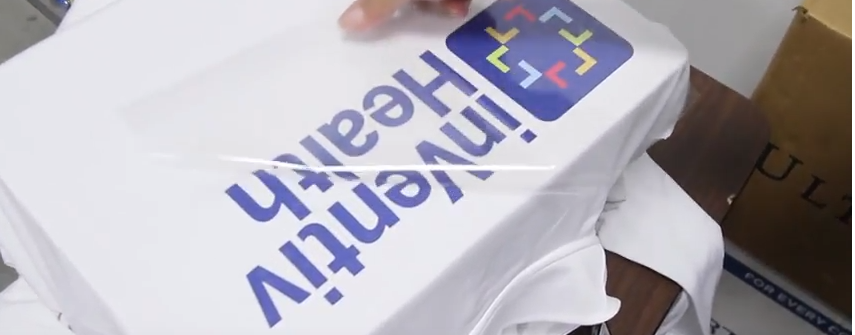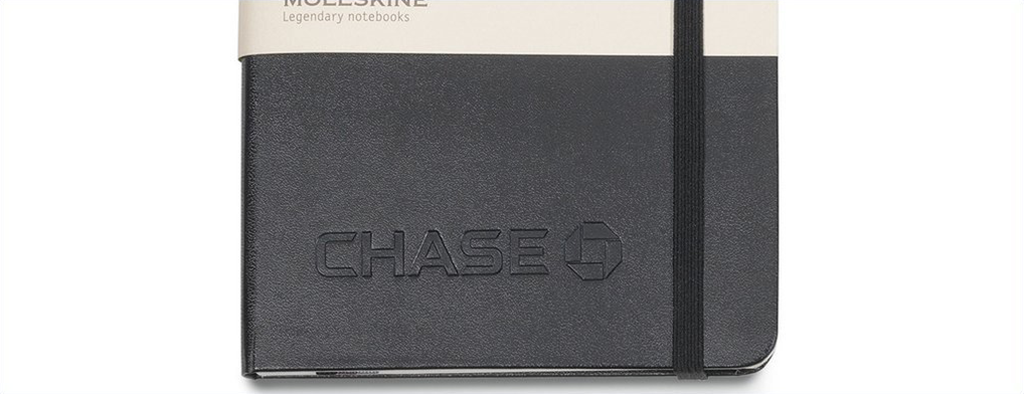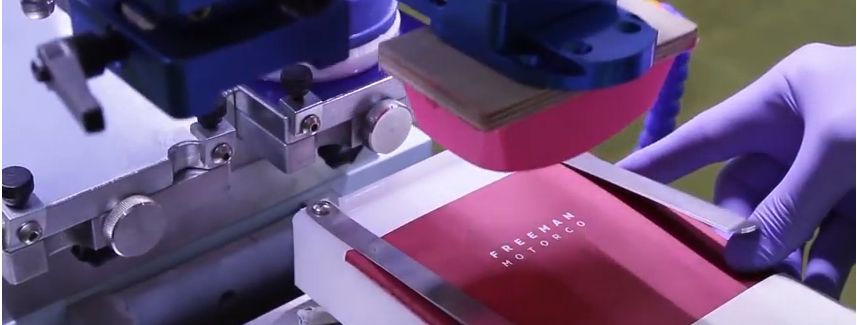Custom Logo Branding Methods
Custom Logo Branding Methods
With so many different options out there for branding your custom logo apparel or promotional item, how do you know when to use each method? Each branding option comes with certain pros and cons as well as some limitations.
To makes things easy, most of our products have a recommended or default branding method and our dedicated team of Merchologists is always here to assist you if you have any questions. To make things even easier, the custom logo experts at Merchology have broken down the major branding techniques below. Jump to your desired branding type using the links below and click into each section for more information on our custom capabilities for each branding type!
| Embroidery | Screen Printing | Heat Transfer | Debossing |
| Laser Engraving | Foil Stamping | Digital Printing | |
| Pad Printing |
|
Embroidery
By far our most popular branding style! The logo on your screen first needs to be "digitized"; mapped out for an embroidery machine based on the intricacies of a logo & its colours. From there, the appropriate thread colours are chosen, a sample stitch out is run, and once approved, your order is put on embroidery machines that read the final digitized file and embroider your logo to its exact specifications. You can read our complete step by step guide to embroidery here!
When to Use Embroidery as a Branding Method
Embroidered logos typically look best on polos, jackets, woven shirts, caps, and bags, but this is a truly versatile style of branding. We've embroidered just about every style of apparel & accessory on our site!
Embroidery is Ideal for…
- Custom Polo Shirts
- Custom Hats, Beanies & Visors
- Custom Jackets
- Custom Sweatshirts & Layering
- Custom Backpacks & Bags
- Custom Embroidered Towels & Blankets
- Much more
Benefits of Embroidery as a Branding Method
- There is an added texture to the design
- The product does not need to be laid flat like in printing, making embroidery suitable for hats and bags
- The intricate design evokes a high perceived value and sense of professionalism
- More durable and resistant to damage from washing than most branding methods
Drawbacks of Embroidery as a Branding Method
- Number of colours used in the design is limited to the thread colour options and prices typically increase with additional colours
- Embroidery is only a suitable branding method for fabric
- Embroidery machines can struggle with small lettering or fine details in design
Screen Printing
An easy way to think about this is as a photographic stencil process. A stencil is created and then is used to apply layers of ink directly onto a product. The result is the screen's image transferred to the print surface. The versatility of this branding method allows it to be used on a wide variety of items. You can read our complete step by step guide to custom screen printing here!
When to Use Screen Printing as a Branding Method
Screen printing, also known as silk screen printing, is the most cost-effective method for large quantity print runs (around 50+ items) and works especially well with items like t-shirts and tanks. A complex design with many different colours requires different stencils for each colour, so this branding method is best for logos with 4 colours or less.
Screen Printing is Ideal for…
- Custom T-Shirts
- Custom Activewear & Sports Apparel
- Screen Printed Sweatshirts
- Promotional Pens & Custom Printed Notebooks
- Custom Drinkware
- Screen Printed Electronics
- Custom Golf Balls
- Much more
Benefits of Screen Printing as a Branding Method
- Most cost effective branding method for larger custom apparel orders
- Just about any design can be applied to any product through screen printing
- Ink is applied thicker than digital printing, making your design more vibrant and easier to see on darker fabrics or surfaces
Drawbacks of Screen Printing as a Branding Method
- Necessity to create screens means screen printing is not ideal for smaller order sizes or individually personalized items
- Prices typically increase on orders with a high number of colours
Heat Transfer Printing
If you have ever used an iron to press a decal onto a shirt then you know the basis of heat transfer, but our method is exceptionally more advanced. The digital heat seal branding method utilizes regulated heat and pressure to thermally bond graphics onto a material’s surface. You can read our complete step by step guide to custom heat transfer printing here!
When to Use Heat Transfer as a Branding Method
Heat transfer, also known as digital transfer, is a great branding choice if you are looking for affordable design options with unlimited colours. With branding methods like embroidery and screen printing you are using physical resources - thread and ink - to create a logo. This cost can be avoided with heat transfer, making it the most ideal branding option for smaller orders.
Heat Transfer is Ideal for…
Benefits of Heat Transfer as a Branding Method
- Minimal set up costs and equipment make heat transfers ideal for smaller order sizes
- Affordable individually personalized branding, such as sports uniforms
- Allows for finer details and smaller text than embroidery
- Heat transfer is available in many different finishes and styles
- Environmentally friendly
Drawbacks of Heat Transfer as a Branding Method
- Logos and designs larger than 15 inches tend to be more expensive than other design methods
- Image does not last as long as some other branding methods and the printed area is not very breathable
- Unable to use an iron on the printed area of the garment
- When logos are too large the texture of the design can be thrown off
- Should not be done on certain synthetic materials that can’t be exposed to the high heat from the iron
Debossing
Debossing gives your logo a 3D element. Dies are constructed from metal in the shape of your logo. Heat and pressure push into the product and form the material into the impression you want. This branding method produces stunning & sophisticated results and is perfect for leather decorating. You can read our complete step by step guide to custom debossing here!
When to Use Debossing as a Branding Method
Perfect for products where subtle and high perceived value is appropriate. A crisp debossing adds lasting value to items used every day as well as unique dimension and quality to your product. Ideal products are leather goods such as padfolios, money clips, or luggage tags.
Debossing is Ideal for…
- Custom Notebooks & Journals
- Custom Home Goods & Tools
- Custom Outerwear
- Personalized Speakers
- Water Proof Apparel
Benefits of Debossing as a Branding Method
- Creates dimensional depth and detail by depressing your design onto the material
- Doesn’t create holes in fabric like embroidery, making it ideal for water-proof apparel
- Works extremely well on leather apparel or surfaces
- Can be done in conjunction with other types of branding
Drawbacks of Debossing as a Branding Method
- Can not be done across seams or zippers
- Small text or highly detailed designs do not work as well with debossing
Laser Engraving
A unique application where the laser removes a thin layer of fibre or pigment dye. By adjusting the intensity and speed of the laser we can sculpt dimension into the design, resulting in stunning clarity and precision. You can read our complete step by step guide to custom laser engraving here!
When to Use Laser Engraving as a Branding Method
This method creates sharp, crystal-clear logos that are unable to be peeled off. Ideal for items that get continuous use such as promotional pens, custom drinkware and personalized tools.
Laser Engraving is Ideal for…
- Custom Engraved Pens
- Custom Water bottles & Tumblers
- Engraved Mugs
- Custom Home Goods, Kitchenware & Tools
Benefits of Laser Engraving as a Branding Method
- Go-to decoration method for metal products
- The engraving process itself is cheap and can be done very quickly
- Designs are extremely durable, making them ideal for frequently handled items
Drawbacks of Laser Engraving as a Branding Method
- Laser engraving machines are expensive
- Laser engraving is typically only performed on metal or wood surfaces
Foil Stamping
Foil stamping is a specialty printing process in which a metallic or pigmented foil is heated with a magnesium dye and then stamped with enough pressure to seal a thin layer of foil to the surface. Metallic foils are typically gold or silver and pigmented foils are most commonly red or black.You can read our complete step by step guide to custom hot foil printing here!
When to Use Foil Stamping as a Branding Method
Metallic foils have a glossy, polished finish and are a great way to make your logo pop on darker coloured surfaces. Because ink is not involved in the process, the colour of your desired surface will not impact the design. This method is used exclusively on custom notebooks and journals at Merchology.
Foil Stamping is Ideal for…
Benefits of Foil Stamping as a Branding Method
- The polished and glossy finish stands out on any colour surface
- Foil stamping does not use ink, so the colours of your design will not be influenced by the surface colour
Drawbacks of Foil Stamping as a Branding Method
- Foil stamping is not a branding method for apparel and is usually only utilized on hard goods
- Can’t be used in conjunction with designs that use thermography because the heat from the foil stamping process will melt the resins
Digital Printing
You can think about digital printing, or direct to garment printing, as a similar process to printing a document from your computer. An image is created with no restraints to the number of colours or type of artwork used, and the image is printed or affixed directly onto the material. With embroidery & screen printing, you are dealing with physical resources (thread & ink) to create a logo; with digital printing, full colour, high definition logos can be done economically, even in small quantities. You can read our complete step by step guide to custom DTG digital printing here!
When to Use Digital Printing as a Branding Method
Commonly used as a substitute for screen printing on smaller orders, digital printing also works well with logos that require a high amount of detail or are very graphic heavy. This is also a commonly used option for logos that contain a gradient, as the print can closely match the digital version seen on a computer screen. Check out our breakdown of the differences between screen printing and digital printing here.
Digital Printing is Ideal for…
Benefits of Digital Printing as a Branding Method
- Easier set up than screen printing – no screen creation or colour separation required
- Ability to print more precise details in a broader range of colours
- Great for smaller order sizes
Drawbacks of Digital Printing as a Branding Method
- Digital Printing is typically more expensive than screen printing for large orders
- DTG Machines can only print on 100% cotton fabric
- Digital Printing is slower than screen printing for large orders
- DTG Machines can struggle with printing multi-colour designs on dark fabrics
Pad Printing
Pad printing is a branding technique in which ink is transferred from a silicone pad onto your desired surface. The pad printing process can be thought of as a more advanced version of stamping – a pad with ink is pressed onto the product and then left to air dry. You can read our complete step by step guide to custom pad printing here!
When to Use Pad Printing as a Branding Method
Pad printing is a very versatile branding method, in that it can be applied to just about any product regardless of shape or form. This makes it especially useful on rounded surfaces like golf balls, pens and water bottles.
Pad Printing is Ideal for…
- Custom Logo Electronics
- Custom Notebooks and Stationary
- Personalized Golf Balls
- Custom Water Bottles & Drinkware
Benefits of Pad Printing as a Branding Method
- Superior image clarity
- Easier than screen printing for printing on unusually shaped objects
- Improved resolution on smaller fonts and designs over screen printing
- Pad printing is a gentle branding technique, making it ideal for delicate materials and fabrics
- Low set-up costs and minimal equipment required
Drawbacks of Pad Printing as a Branding Method
- Not ideal for designs with a lot of different colours
- Pad printing process can be slow because you must change pads for each colour and allow drying time
- Typically more expensive than screen printing











